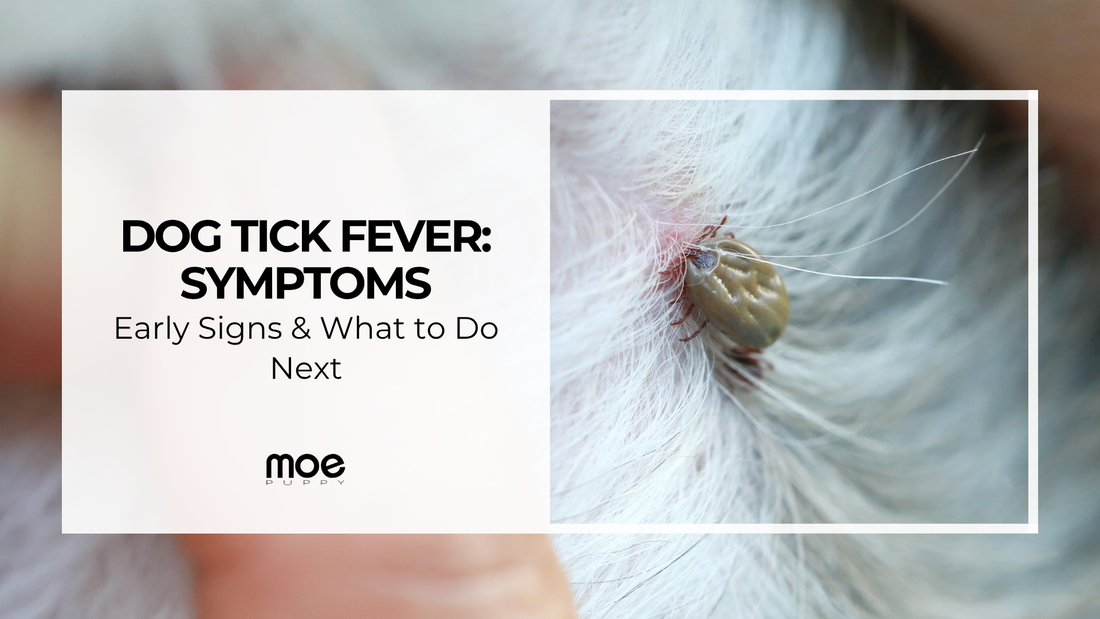
Dog Tick Fever: Symptoms, Early Signs & What to Do Next
Share
Ticks may seem like small nuisances, but for your dog, they can turn into a serious health threat. One of the most concerning consequences of a tick bite is Dog Tick Fever, a condition that can be life-threatening if not identified and treated early. It’s more than just an itchy bite—tick fever is caused by bacteria that ticks carry and transmit into a dog’s bloodstream. And the worst part? Dogs can get very sick before we even notice there’s something wrong.
Let’s break it down in a simple, honest way: what causes dog ticks, why it's so important to keep them away, how to spot the early signs of Dog Tick Fever, and what you can do to prevent it from happening in the first place.
How Do Dogs Get Ticks in the First Place?
Ticks are tiny parasites that feed on the blood of their host—and dogs are one of their favourites. Dogs usually get ticks when they go outdoors, especially in grassy areas, gardens, parks, or during walks in areas with dense vegetation. Stray dogs, untreated pets, or infected surroundings can also be a source of ticks. But what makes the situation worse is the monsoon.
Monsoon is Tick Season.
With high humidity and moist surroundings, ticks and fleas thrive and multiply rapidly. The damp environment creates a perfect breeding ground, making the risk much higher during this time of the year. Dogs who love puddles or outdoor play are at higher risk. That’s why regular tick checks are so important during and after monsoon walks.

Tick and Flea Infestations: A Dangerous Duo
Fleas and ticks often appear together, forming a duo of trouble for pets and their owners. While fleas cause itching, irritation, and even allergic reactions, ticks are far more dangerous due to their disease-carrying abilities.
One common misconception is that fleas are more bothersome because they’re easier to spot, but it’s the tick you don’t see that causes the real damage. A single tick bite can result in severe illness, whereas flea infestations, though uncomfortable, usually don’t result in life-threatening conditions.
That said, dog tick and flea control must go hand-in-hand. Where you find one, the other may follow. Both love similar conditions — warm, moist environments and access to hosts with thick fur. Keeping your dog protected from both is essential for their well-being.
Early Signs of Dog Tick Fever
Most tick-borne illnesses show up slowly at first. This is what makes them so dangerous—you might think your dog is just having an off day. But recognizing early symptoms could save their life.
Dog Tick Fever is one of the most common diseases spread by ticks on dogs, especially in regions with a warm and humid climate. It’s caused mainly by the bacteria Ehrlichia canis, which enters the bloodstream through a tick bite.
Watch out for:
-
Lethargy – If your energetic pup suddenly seems tired and uninterested in play, it could be more than just fatigue.
-
Loss of appetite – Skipping meals is one of the first things that might happen.
-
High fever – Fever over 103°F is a red flag.
-
Swollen lymph nodes – You may notice swelling under the jaw, behind the knees, or around the shoulders.
-
Painful joints or stiffness – They might limp, hesitate to jump, or seem sore.
-
Discharge from eyes or nose – In some cases, you might notice mucus or watery discharge.
- Unexplained bruising or bleeding – Nosebleeds or tiny red spots on the belly can be signs of platelet problems, which Dog Tick Fever can cause.
Also Read: Why is Your Dog Scratching? Understanding Dogs and Ticks
Why Prevention Is Better Than Cure
Let’s be honest — once a dog has a tick-borne disease, recovery isn’t simple. Treatment often involves a long course of antibiotics, follow-up testing, and symptom monitoring. That’s stressful for both pet and parent, and not to mention, expensive.
This is why tick prevention is far more effective and less traumatic. By stopping ticks from ever attaching to your dog in the first place, you’re avoiding the root cause of serious illness.
Daily tick checks, regular grooming, and most importantly, protective products are non-negotiable for responsible pet ownership.

Tick Prevention: Keeping Your Dog Safe Year-Round
Now that we know how dangerous a single tick can be, the next step is prevention. Fortunately, tick prevention today is more effective than ever—and it’s not about over-the-top treatments or complicated routines.
The key is consistency and using the right repellents and protective methods.
Here’s what responsible prevention looks like:
-
Regular Use of Dog tick repellent spray: Safe and gentle anti-tick sprays specially made for dogs are ideal for outdoor walks or after playtime. These sprays act as a barrier to keep ticks away from your dog’s coat and skin.
-
Tick-Defense Shampoos: Bath your dog with dog tick shampoo, Perfect for deep cleansing and repelling both ticks and fleas with regular use. This should be part of your monthly grooming routine, especially during warmer months.
-
Checking After Outdoor Activity: After walks or hikes, run your fingers through your dog’s coat and inspect areas like behind the ears, under the legs, around the tail, and between the toes.
-
Keeping Your Dog’s Sleeping Area Clean: Regularly wash their bedding and vacuum surrounding areas to avoid tick eggs or larvae from settling in your home.
-
Avoid Long Grass or Untrimmed Areas: If possible, avoid letting your dog roam in thick, grassy patches, especially during peak tick season (spring and summer).
- Vet Checkups and dog tick treatment: Regular blood tests can help detect tick fever in its early stages—even before visible symptoms appear. Some infections can remain in a dormant stage and only show signs when the dog’s immunity is low.
Tick-Related Syndromes to Watch Out For
Beyond Dog Tick Fever, here are a few other tick-borne diseases and syndromes dog owners should be aware of:
-
Lyme Disease: Causes inflammation, joint pain, fever, and long-term mobility issues.
-
Babesiosis: Leads to anemia, pale gums, and weakness due to destruction of red blood cells.
-
Anaplasmosis: Brings symptoms similar to Lyme, including joint pain and fatigue.
-
Tick Paralysis: Some ticks secrete neurotoxins that can lead to progressive paralysis starting from the legs and spreading upward.
-
Hepatozoonosis: A rare but serious disease that causes muscle pain, fever, and lethargy, often due to ingesting an infected tick.
Being aware of these conditions can help you take quick action if symptoms appear. But again, it all circles back to one major step: tick prevention.
Conclusion
Ticks are not just a nuisance; they’re a real health threat to your dog. From Dog Tick Fever to more severe complications like paralysis or chronic joint pain, the dangers are too serious to ignore. The good news? You have the power to protect your pet. With daily checks, regular grooming, and trusted tick control products, you can help your dog live a long, healthy, and tick-free life.
Whether you’re walking your dog through city parks or rural trails, make dog tick prevention a daily habit. Your pup depends on you to keep them safe — and stopping ticks is one of the most important ways to show your love.

